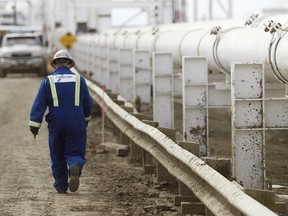
Oilsands operators continue to crank up production in 2024, filling pipelines and fuelling plans to add transportation capacity out of Western Canada in the coming years.
Pipeline giant Enbridge reported Friday that its Mainline system, which moves crude oil to Eastern Canada and into the U.S. Midwest., shipped an average of 3.1 million barrels a day during the second quarter.
Record volumes moved on the Mainline in the April-to-June period, up three per cent from a year earlier — and occurring during the same period the Trans Mountain expansion began operating.
Canadian petroleum producers continue to face apportionment on the Mainline network in July and likely in August, as nominated volumes from shippers exceed available capacity.
Enbridge executives said they’re advancing talks with customers to increase the Mainline’s capacity out of Western Canada by about 150,000 barrels per day (bdp) in late 2026, through optimization and smaller expansion initiatives.
“We are teeing up some assurance egress at a minimum,” Enbridge president of liquids pipelines Colin Gruending said Friday during an earnings call.
“It’s likely it will get used in the 2026-27 period. We’re (discussing) that with industry. There’s a significant interest at this time.”
In May, the Trans Mountain expansion (TMX) began operating, providing relief for a sector that has needed a significant jump in pipeline capacity for much of the past decade. At times, western Canadian producers have faced a steep price discount for their crude compared with benchmark U.S. oil due to the bottleneck.
However, the $34-billion expansion of Trans Mountain almost tripled the capacity of the existing pipeline that ships oil products from Alberta to Burnaby, B.C., for export.

But a series of second-quarter results have been released this week, highlighting just how much Canadian production has climbed as additional pipeline space has become available.
On Friday, Imperial Oil reported its second-quarter production averaged 404,000 barrels of oil equivalent (boe) per day, an 11.3 per cent increase from the same period in 2023.
Canadian Natural Resources, the country’s largest producer, said Thursday its daily output hit 1.28 million boe a day in the April-to-June period, an eight per cent jump from a year earlier.
And Cenovus Energy indicated its production topped 800,000 boe a day in the quarter, up almost 10 per cent. (MEG Energy previously announced its average bitumen output climbed six per cent to 102,000 barrels a day during the first half of the year compared to 2023.)
The startup of TMX, buoyant oil prices and new measures to reduce maintenance interruptions in the oilsands — boosting annual output in the process — are helping Canadian companies open the taps and grow, said analyst Phil Skolnick of Eight Capital.
“They see a window opening,” Skolnick said.
“It is a new era for growth because you have the transportation, you have the oil prices and you have balance sheet strength.”
With companies such as Imperial, Canadian Natural Resources and Cenovus developing plans to further increase production, some analysts expect pipeline capacity out of the region will fill up within a few years.
“There’s been a number of different theories. Some of the . . . pipeliners are thinking it’s going to be a shorter period of time than the producers,” Cenovus CEO Jon McKenzie said Thursday.
“We think at some point, the history of this basin is we do fill available pipeline space, but we also think that we have a number of other options to move more barrels out of this province.”
Earlier this year, Cenovus discussed growing its output to about 950,000 boe a day by 2028.
Near-term growth for Canadian Natural Resources includes adding capacity at the Athabasca Oilsands Project, while it could incrementally boost output at its Horizon operations by 195,000 barrels per day over the longer run.
Having sufficient transportation capacity out of the region is important, along with finalizing plans by the Pathways Alliance — Canadian Natural is a member of the group of large oilsands operators — to reduce oilsands emissions, company president Scott Stauth said in an interview.
“I suspect that it’s going to take at least a couple of years before TMX is running at its named capacity. However, if you look forward . . . we will look to see companies, such as TMX and Enbridge Mainline, relook at their systems and look at opportunities for potential expansion,” Stauth said.
“We want to ensure that we have the opportunity to move those barrels to market.”
Imperial began producing oil from its new solvent-assisted Grand Rapids thermal oilsands project at Cold Lake during the second quarter. It’s now producing about 11,000 bpd and expects it to reach output of 15,000 bpd later this year.
“We do see significant running room beyond this first phase,” CEO Brad Corson said on an earnings call.
Canadian oilsands output has risen by 1.3 million bpd over the past decade. A report by S&P Global Commodity Insights this spring forecast production will increase by an additional 500,000 barrels a day, reaching 3.8 million bpd by the end of this decade.
S&P Global vice-president Kevin Birn said TMX has given the sector some time before current pipeline capacity fills. Yet, he noted planned production increases could challenge those levels around 2026, unless enhancements to pipeline networks or additional crude-by-rail shipments take place.
Meanwhile, Enbridge is examining its strategies to grow the Mainline’s capacity.
“With the strength in supply growth and appetite to get to U.S. markets continually in the bid, pulling it that way, industry is casting its eye to the future,” Gruending added.
Chris Varcoe is a Calgary Herald columnist.